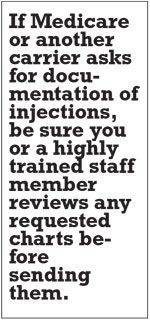 |
|
Have a question for “Coding Commentary”? Tweet it to us at | |
|
Bio |

|
| Image courtesy of Getty Images |
In the course of your usual retinal clinic, you undoubtedly perform numerous intravitreal injections. Intravitreal injections are now common to the point that they’re under scrutiny by Medicare and other payers.
It’s somewhat logical for Medicare to be interested in the procedure and associated drugs. In 2018, the most recent for which data are available, Medicare paid providers $2.9 billion for injections of aflibercept (Eylea, Regeneron Pharmaceuticals) and ranibizumab (Lucentis, Genentech/Roche). In 2017, Medicare paid a total of $9 billion to ophthalmologists, with IVI drug expenses accounting for more than 38 percent of that total. The sheer cost to the Medicare trust fund impels the Office of the Inspector General to carefully monitor physician billing for these drugs.
Documentation to avoid traps
To meet billing requirements for Medicare and most commercial payers, your medical record should include adequate information to support the charge. Before you begin the procedure, you must confirm that a minimum of 28 days has passed since the previous injection in the same eye. The likelihood of denial is high if you perform intravitreal injections more frequently than every 28 days. For Medicare you’ll most likely need to appeal more frequent treatments with a letter of medical necessity. With that trap avoided, your clinic note should include:
- A surgical plan or order. This should include the drug name, the dosage, and the indication, along with the physician’s signature.
- Medical necessity. This should include the diagnosis, indications, and changes to the patient’s condition; diagnostic test results; and patient consent for the procedure and acceptance of risks.
- Documentation of physician informed consent. This should consist of the signed consent form for first-time injection; any change in medication or eye injected; and consent signed annually thereafter.
- For new patients, why one drug was selected over other options.
- For established patients, a description of how the patient is responding to therapy at each visit.
- The operative note. This must include the volume and dose of the injected drug, the lot number and expiration date, as well as how much (if any) was wasted or discarded. A notation of “no drug was wasted” or “only manufacturer overfill was discarded” may satisfy a payer’s requirement.
- A notation of any complications. Clear documentation of the complication, including medication errors—or, conversely, if no complications occurred—is in order. If the wrong medication was used, be sure to educate the patient and consider not submitting a claim to insurance. Your malpractice carrier can advise you on next steps if this occurs.
Of course, as with all documentation guidance, your chart note must be clear and legible.
The 28-day trap
Medicare and other payers base their policies in part on the Food and Drug Administration-approved indications. Ranibizumab specifies 28 days between doses. Although the package insert for aflibercept is worded more broadly, it states that dosing once every four weeks is the maximum frequency. (Of course, 4 x 7 = 28!)
Rather than attempt to count weeks, Medicare used the original approved anti-
VEGF for ophthalmology (ranibizumab) as the standard for these drugs. Some Medicare carriers often apply the same requirement for intravitreal injections of bevacizumab (Avastin, Genentech/Roche), although there are no FDA guidelines for ophthalmic use.

|
What to do if you’re audited
If Medicare or another carrier asks for documentation of injections, be sure you or a highly trained staff member reviews any requested charts before sending them. Include in the packet:
- Notes with the patient’s name and date of service. They should appear on every page.
- Relevant history and prior treatments to support medical necessity. If a prior visit contains the physician’s order for the treatment under review, be sure to send that note.
- Any diagnostic test results supporting the need for continued treatment. Include tests even performed at a prior visit.
- The operative note. Include all of the information cited earlier.
- Any relevant correspondence. For example, include referral letters that support the therapy.
Never alter any records after receiving a request. However, you may want to supplement the records you send to give the carrier assistance with their record review. This supplement may include:
- Explanations of common abbreviations you use.
- A signature. This consist of either a log (for paper records) and/or your electronic health record protocol for physician signatures in electronic medical record.
- The insurance coverage policy. This is especially important if the reason for the treatment is uncommon.
Also, if the drug was used off-label, consider including peer-reviewed articles supporting your use.
Better yet, just avoid the audit
Be sure you know how your utilization compares to national averages. If you bill a significantly higher percentage of IVI compared with your peers, there’s a strong likelihood that you’ll be audited. This doesn’t mean you’re doing anything wrong; it just means you need to be especially diligent with your documentation—and be prepared. Having a reliable, trained and independent staff member or peer perform regular internal audits is invaluable to ensure that your documentation is adequate and appropriate.
Also, write or modify policies and checklists to formalize your intravitreal injection procedures as vulnerabilities are exposed. And don’t forget to attend periodic training for yourself and staff members.
It can be easy to fall into a routine and let protocols erode over time. Avoiding that trap is important. With proper documentation, your continued use of these vision-saving drugs will be paid appropriately and you’ll avoid audit traps. RS
REFERENCES
1. Frontz AJ. Department of Health and Human Services Office of Inspector General. An ophthalmology clinic in California: Audit of Medicare payments for eye injections of Eylea and Lucentis. March 2021. Report A-09-19-03022. Available at: https://oig.hhs.gov/oas/reports/region9/91903022.pdf Accessed October 18, 2021.
2. Information compiled by Corcoran Consulting Group from Centers for Medicare and Medicaid Services claims data for 2017.
3. Lucentis [package insert]. South San Francisco, CA: Genentech; 2014.
4. Eylea [package insert]. Tarrytown, NY: Regeneron Pharmaceuticals; 2011.
5. Sample minor procedure operative report that may be used as a starting point. Corcoran Consulting Group. Available at: https://www.corcoranccg.com/products/forms/operative-report-forms/minor-procedure-operative-report/. Accessed October 18, 2021.




